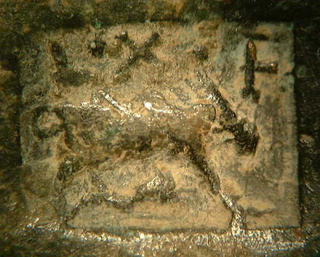10-й наш отдельный легион

Как известно Римские легионы выпускали свою внутреннюю валюту. Обычно иэношенные до неузнавания старые монеты штамповались соответствующими змблемами. Вот например, одна редкая монета Х легиона стоявшего в Ирусалиме около 200 лет и появившегося в Иудее около 6-го года нашей эры. Понятно о каких временах и событиях идет речь.
Для чего были нужны такме монеты?.
Цитата из книги Давида Гендина "Guide to Biblical Coins" :
There has been much discussion about why people countermarked coins in ancient times. Both civil and military countermarking took place, and countermarks of Roman Legions apply to the latter. In his comprehensive book Greek Imperial Countermarks, Christopher Howgego says, "Countermarking took place in military contexts in many parts of Roman Empire."
He observes that, "Legionary countermarks are usually found on worn coins. It is likely that their primary purpose was to make such coins acceptable to the troops as pay or change. Since each group of legionary countermarks ( in the east at least ) is found on one size coin only, they may have guaranteed a specific value also. The evidence of finds does not suggest that the countermarks turned the coins into tokens for use by legions only. The countermarks could be applied either at a legion's permanent camp or an campaign, and probably by detachments as well as legions.
It is possible that countermarking of coins was necessary for the legionary soldiers more as a psychological tool than a fiscal one. After being drilled and "psyhed" into hating their enemies, the legionnaires may have been unable to adapt to local coinage without its being stamped with their own insignias. Of course the very visible circulation of countermarked coins could also have a devastating psychological effect on the people living in the territory occupied by legionary force.
Последний абзац не совсем убедителен. При отсутствии фактов, можно найти другое логичное объяснение существования подобных монет.
Предположим, что Римляне не желали, чтобы определенные товары попадали в руки местного населения.
Например вооружение.
Такие товары следовало продавать в специализированных магазинах (как Березка), а суровый образ дикой свиньи выбитый на монете и так не любимый евреями, сужал рынок до самих Римлян.
Или эти монеты могли использоваться как билеты. Вы покупаете такую монету заранее, а затем отдаете ее на входе.
Странным является то, что вообще можно было ставить какие то там штампы на портрет императора. В Риме с этим было строго.
Вот найденное на интернете описание моей монетки:
Colonial coin of Domitian, circa 70-96 CE. Reverse shows two countermarks. The top one is struck vertically and represents a Roman galley with oars, sailing to the right. The larger countermark shows a wild boar with a dolphin beneath, and the letters L•X•F above. The letters stand for the Legion X, Fretensis. The galley and the dolphin both allude to the famous naval battle of 36 BCE where the Tenth Legion under Agrippa destroyed the forces of Gnaeus Pompey off the Coast of Sicily. The nickname Fretensis is taken from "Fretum Siculum," which loosely translates to the Straits of Sicily, which were located off the Cape of Naulocus, where the naval engagement occurred.
Штампики имеются и на обверсе.
Диаметр: 22 мм
Вес: 11.1 грамм





0 Comments:
Post a Comment
<< Home